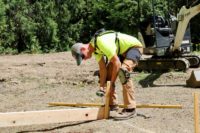On-site Consultation Program
OSHA's primary compliance assistance program is its On-site Consultation Program. We understand that most small businesses want to protect their employees, but often cannot afford to hire a health and safety professional. This help for small businesses is critical both for the health of these businesses and for the safety and health of the millions of workers employed by small businesses.
OSHA's On-site Consultation Program is designed to provide professional, high-quality, individualized assistance to small businesses at no cost. This service, budgeted at $57.8 million, provides free and confidential workplace safety and health evaluations and advice to small and medium-sized businesses with 250 or fewer employees, and run by the states, separate and independent from federal or state OSHA's enforcement programs.
In FY 2015, OSHA's On-site Consultation Program conducted more than 27,800 free visits to small and medium-sized business worksites, helping to remove more than 3.5 million workers from hazards nationwide. A full 87% of those visits were to businesses with fewer than 100 employees.
This program doesn't just help protect workers; it also helps businesses save money. After numerous years of reporting relatively low injury cases, Chemung Advocacy, Resources and Care (ARC), of Elmira, New York, which was established by parents interested in providing support services for their developmentally disabled children, experienced a spike in recordable injuries and requested a free consultation visit from OSHA's On-site Consultation Program, administered by the New York State Department of Labor.
Chemung ARC corrected all of the hazards identified by the consultant. By the following year, the company's Days Away from Work, Restricted Work or Job Transfer (DART) rate had dropped to 58% of the average rate reported by the BLS for the vocational rehabilitation services industry. In addition, the organization's Total Recordable Case rates dropped from 4.0 to 1.0 (compared to the industry incidence rate of 5.7 in 2014) over a two-year period. The reduction in recordable injuries had a direct impact on the company's workers' compensation costs — its premiums dropped 12.5% in the year following the free onsite consultation visit.
OSHA also continues its strong support for recognizing those employers who "get" safety. For small employers, the OSHA On-site Consultation Program's Safety and Health Achievement Recognition Program or SHARP program, recognizes small businesses that have achieved excellence. In addition, OSHA's Voluntary Protection Program (VPP) recognizes employers and workers in industry and federal agencies who have implemented effective safety and health management systems and who maintain injury and illness rates below the national average for their industries. In order to participate in these programs, employers commit to implement model safety and health program management systems that go far beyond OSHA's requirements. These employers demonstrate that "safety pays" and serve as a model to all businesses.
Outreach and Training
For the vast majority of employers who want to do the right thing, we want to put the right tools in their hands to maintain a safe and healthful workplace. That is why we invest in our compliance assistance materials. New OSHA standards and enforcement initiatives are always accompanied by web pages, fact sheets, guidance documents, on-line webinars, interactive training programs and special products for small businesses. In addition, our compliance assistance specialists, found in most of our 85 Area Offices across the nation, supplement this with a robust outreach and education program for employers and workers.
A major initiative of this administration has been increased outreach to hard-to-reach vulnerable workers, including those who have limited English proficiency. These employees are often employed in the most hazardous jobs, particularly in construction, and may not have the same employer from one week to the next. We have particularly focused on Latino workers and others for whom English is not a first language. Latino workers suffer higher work related fatality and injury rates on the job than other workers, often because they are in the most dangerous jobs and do not receive proper training.
Another critical piece of our strategic effort to prevent workplace fatalities, injuries and illnesses is training about job hazards and protections. OSHA's Susan Harwood Training grant program provides funding for valuable training and technical assistance to non-profit organizations — employer associations, universities, community colleges, unions, and community and faith based organizations. This program focuses on providing training to workers in high risk industries and is also increasing its focus on organizations involved in training vulnerable, limited English speaking and other hard-to-reach workers to assure that those workers receive the training they need to be safe and healthy in the workplace.
Alliances and Strategic Partnerships
Where an extra effort is needed in an industry, or there are insufficient standards, OSHA often partners with employers, workers, professional or trade associations, labor organizations, and other interested stakeholders through alliances and strategic partnerships to encourage, assist, and recognize efforts to eliminate serious hazards and enhance workplace safety and health practices in specific industries.
For example, OSHA has worked through an alliance with the National Service, Transmission, Exploration & Production Safety (STEPS) Network and the National Institute for Occupational Safety and Health (NIOSH) to help employers reduce injuries and fatalities in the oil and gas industry. And, we've worked with the American Staffing Association to insist that both host employers and staffing agencies understand their responsibilities to protect temporary workers on the job, and provide them the same protections as all other workers.
We have also joined with stakeholders in the construction industry in an unprecedented nationwide outreach effort to prevent fatal falls in construction. And, in the growing telecommunications industry, we have worked with the Federal Communications Commission, the National Association of Tower Erectors, and leaders in the telecommunications industry to initiate a working group aimed at developing and implementing recommended safety practices for preventing tower worker deaths.
Conclusion
We continue to work hard each and every day to ensure employers are protecting their workers from the myriad of safety and health hazards in workplaces across this country. And, we put great effort into making sure employers have all the necessary tools required to meet their responsibilities. We believe that with our current resources, the balanced approach of targeted enforcement and extensive compliance assistance is the most effective and efficient way for us to achieve our mission.
I want to thank you again for inviting me to this hearing to detail the work that we do. I look forward to your questions.
(1) See, for example: Wuellner, S. E. and Bonauto, D. K. (2014), "Exploring the relationship between employer recordkeeping and underreporting in the BLS Survey of Occupational Injuries and Illnesses." Am. J. Ind. Med., 57: 1133-1143. doi: 10.1002/ajim.22350. See more at: http://www.lexisnexis.com/legalnewsroom/workers-compensation/b/recent-cases-news-trends-developments/archive/2014/08/29/new-study-points-to-significant-underreporting-of-injuries-to-bureau-of-labor-statistics.aspx#sthash.7xn3UQJk.dpuf
(2) https://www.osha.gov/OshDoc/Directive_pdf/CPL_02-00-159.pdf*
(3) 29 U.S.C. §666.
(4) Id.
(5) Id.


